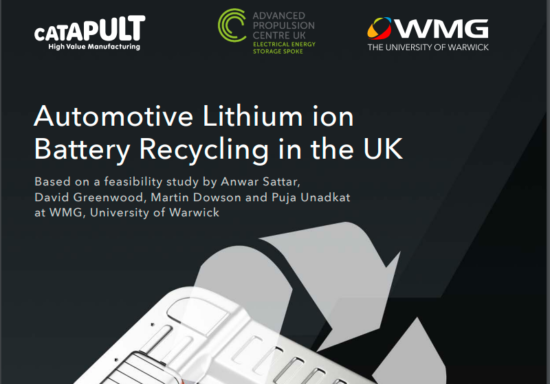UK could lose out to Europe in battery recycling market
 Source: University of Warwick
Source: University of Warwick
The UK is at risk of losing out to the rest of Europe when it comes to the automotive lithium ion battery recycling market, according to a new research report published this week by WMG at the University of Warwick and backed by the Advanced Propulsion Centre UK, the High Value Manufacturing Catapult and Faraday Battery Challenge at Innovate UK.
The new report entitled “Automotive Lithium ion Battery Recycling in the UK” by Anwar Sattar, David Greenwood, Martin Dowson and Puja Unadkat in WMG, at the University of Warwick calls for the UK to move quickly to establish commercial scale recycling for automotive lithium ion batteries.
The WMG report notes that there are currently over a dozen such large scale lithium ion recycling facilities in the rest of Europe but none in the UK despite the fact that the UK is the second largest vehicle market in Europe with annual sales exceeding 2.3 million units in 2019, and is also amongst the top electric vehicle markets in Europe, with a 6 per cent market penetration in the first quarter of 2020.
As the UK lacks significant industrial capacity for lithium ion battery recycling, batteries are shipped to mainland Europe for material recovery. This can be a very expensive process, dependent on state of health of the pack, chemistry of the pack and size of the pack. This can mean that up to 75 per cent of the total cost of recycling (which can range from £3/kg to >£8/kg) may be attributed to transportation costs and other factors such as the state of health and chemistry of the cells.
Even more concerning are the report’s comments that without its own significant recycling facilities, the UK could also be losing out on a major source of expensive and difficult to source materials to help manufacture new batteries.
By 2040, 339,000 tonnes of EV batteries are expected to reach their end of their life annually. The average value in end of life automotive packs is £3.3/kg for Battery Electric Vehicles and £2.2/kg for Plug-in Hybrid Electric Vehicles.
By 2040, the UK will also require 140GWh worth of cell production capability, representing 567,000 tonnes of cell production per year. Recycling can supply 22 per cent of this demand (assuming a 60% recycling rate and 40% reuse or remanufacture). The break-even point for an automotive lithium ion battery recycling plant is just 2,500 – 3,000 tonnes per year if the chemistry contains nickel and cobalt.
To satisfy 2040 demand, the UK will need 133,000 tonnes of cathode metals per year. Much of this material can be supplied by recycling end of life batteries (see table):
| Metal | Demand (tonnes per year) | Potential sourcing from Recycling (tonnes per year) |
| Lithium | 14,000 | 3,000 |
| Nickel | 96,000 | 20,600 |
| Manganese | 11,000 | 2,400 |
| Cobalt | 12,000 | 2,600 |
Source: WMG, University of Warwick. Based on 8:1:1 chemistry, assuming 60% of end of life batteries are recycled in 2040.
One of the reports authors, Professor David Greenwood Professor of Advanced Propulsion Systems, in WMG at the University of Warwick, concluded: “Electric vehicles offer huge potential for decarbonising transport and improving air quality, but as we accelerate their early market we must equally be thinking about what happens at the end of their useful life. Batteries in particular contain significant quantities of materials which are costly to extract and refine and which could be hazardous to the environment if improperly disposed of. Investment is needed to create suitable recycling facilities in the UK within the next few years, and beyond that, research is needed to allow economic recovery of much greater proportions of the battery material. In doing so we will protect the environment, secure valuable raw materials, and reduce the cost of transport.”
The full report can be downloaded here: https://warwick.ac.uk/fac/sci/wmg/business/transportelec/22350m_wmg_battery_recycling_report_v7.pdf.

 Cooper
Cooper Nokian Tyres; Dr. Falk Köhler PR
Nokian Tyres; Dr. Falk Köhler PR

Comments